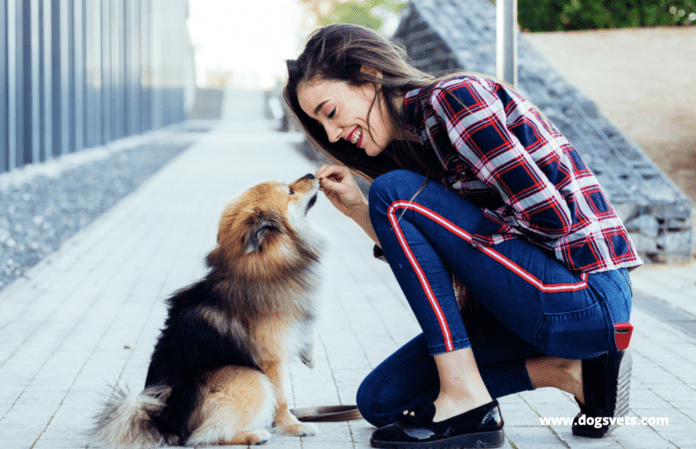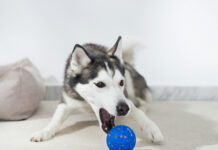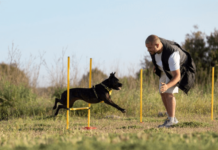Last Updated on February 25, 2024 by Dogs Vets
When Should I Start Training a Dog? – 10 Things to know
So, you’ve decided to delve into the world of dog training. It’s an exciting journey, but before you unleash your inner dog whisperer, there are some crucial aspects to understand.
From the basics to the finer details, we’re here to guide you through the essential rules of dog training.
Understanding Your Pup’s Mind – A Canine Crash Course
Before diving into the training arena, it’s imperative to comprehend your furry friend’s psyche. Dogs thrive on routine, positive reinforcement, and clear communication. They’re like sponges, absorbing information and cues from their environment.
To train effectively, you need to think like a dog – that’s your golden ticket.
Setting the Right Foundations – Puppy Training 101
Puppies are like clay waiting to be molded, and the earlier you start, the better.
- Socialization: Proper socialization is the cornerstone of a well-behaved dog. Introduce your puppy to various environments, people, and other pets. This helps build their confidence and minimizes behavioral issues later on.
- Basic Commands: Start with basic commands like sit, stay, and come. Use positive reinforcement, such as treats or praise, to associate these commands with positive experiences.
- Leash Training: Teaching your pup to walk on a leash without pulling is essential for both your sanity and their safety. Be patient, and reward them for walking nicely beside you.
Adolescent Pups – Navigating the Teenage Phase
As your pup transitions into adolescence, you might face some rebellion. It’s akin to dealing with a teenager testing boundaries – challenging but manageable.
- Consistency is Key: Stay consistent with your commands and rules. Adolescents, much like teenagers, need structure to understand their place in the family hierarchy.
- Advanced Commands: Build on the basics by introducing more advanced commands. This not only keeps their minds engaged but also reinforces your role as the pack leader.
Adult Dogs – Fine-Tuning and Reinforcement
Congratulations, you now have a full-grown dog. But the training journey doesn’t end – it evolves.
- Ongoing Training Sessions: Regular training sessions keep your dog’s mind active and strengthen your bond. It could be as simple as a quick recall practice in the backyard.
- Addressing Behavioral Issues: If you notice any behavioral problems, like excessive barking or digging, address them promptly. Identify the root cause and work on solutions – sometimes, it’s boredom or anxiety.
Special Considerations – Tailoring Training to Your Dog’s Needs
Every dog is unique, and tailoring your approach to their individual needs is vital for success.
- Breed-Specific Training: Different breeds have different instincts and energy levels. Research and understand your dog’s breed to tailor your training methods accordingly.
- Positive Reinforcement vs. Correction: While positive reinforcement is the preferred method, some dogs respond better to correction. Finding the right balance is crucial for effective training.
Training Challenges – Patience, Persistence, and Perseverance
- Dealing with Setbacks: Training is not always smooth sailing. Be prepared for setbacks and don’t get disheartened. Consistency, patience, and a positive attitude will see you through.
Extra Tips to Know When Should I Start Training a Dog?
When should I start training a dog? Here are a few general guidelines: six months, 7-8 weeks, 7 years, and older.
Depending on your circumstances, you can train a dog at any age. But there is no ideal time to start training your dog.
The age at which your dog should be housebroken is a personal choice.
Some dogs will be more difficult to housebreak at a later age than others, so choose a dog that is at an appropriate age.
A Puppy at 7-8 weeks
Depending on your puppy’s size and temperament, the best time to begin training him is between six and eight weeks of age.
Puppies are highly intelligent, but still too young to fully understand human commands.
They are still developing their brains, so correcting them for misbehavior is not fair.
For this reason, you should limit your puppy training sessions to two or three minutes each, a few times daily. Most importantly, training sessions should be fun and stress-free.
During the early stages of puppyhood, puppies have little bladder control, so they need to go often. As they get older, they become more adept at holding in the wee, and will communicate their need for the bathroom with signs.
Once you’ve taught them these basic commands, you can start working on other commands, such as sitting and walking on a leash. You should also begin potty training with praise.
Dog at 6 months Old
It’s never too late to start training your puppy. Puppyhood is a critical stage in building a dog’s emotional foundation, so training him can never be too early.
If your puppy doesn’t trust you and doesn’t trust his surroundings, he’ll have a tough time learning important life skills later on.
He won’t come when called if he doesn’t feel safe around you, and he won’t always drop his toy when you ask.
Puppy Craze is very common at this age, and your puppy may exhibit it at different times. One minute your puppy is calm and content, the next minute he’s off to a world of mischief.
A puppy’s energy level can quickly change, so try to take him for long walks. You can also play fetch with him to help him burn some energy.
In addition to training your puppy to respond to commands, you’ll also need to introduce new games for him, including fetch.
Dog at 7 years Old
The best time to train a dog is during its adolescent phase, when the puppy has finished its physical growth. This makes it the ideal time to start obedience training, service dog training, and socialization.
A well-behaved pup should be able to respond to commands in seven different directions, including “sit” and “stay.”
It is also a good time to begin training your dog to respond to commands if you’re going to take it for a walk or ride in the car.
There are many reasons why people put off training their dogs. In general, puppies live seven to 10 years.
However, some breeds live longer. A large breed of dog can reach a mature age of seven or eight. A smaller breed can live to a very old age of 11 or thirteen.
Regardless of the breed, it is important to train your puppy early.
If you don’t start training your dog early, you may find yourself with a dog who has no interest in learning new behaviors.
An older dog
Training a dog at an older age can be challenging but it isn’t impossible.
Even if your dog has been in a previous home and learned different behaviors, he will still be eager to please you and learn what makes you happy.
To train an older dog, use positive reinforcement to show him that the new behavior will make you happy. Give your dog treats while training to motivate him to perform a new behavior.
Remember that training an older dog should be fun and rewarding for him,
so you need to reward your dog for it’s patience.
As your dog ages, he will continue to learn new tricks and behaviors, but it will be important to set realistic expectations and work with him in a gentle way. Older dogs should not be pushed beyond their physical abilities.
If you notice any signs of cognitive disorder, you should consult a veterinarian. In addition to age, other factors should also be considered when training an older dog.
If you see signs of cognitive disorder or arthritic pain, you should consider seeking medical attention for your older dog.
Developing emotional foundation
Humans and dogs share many similarities, but their emotional experience is quite different. Humans experience emotion through the cerebral cortex, which is five times larger than that of a dog.
The cerebral cortex is the part of the brain responsible for social inhibition, impulse control, and thinking, so human emotions flow through this area more rapidly than those of a dog.
In fact, our emotional responses are largely influenced by visual cues and facial expressions, so we naturally try to understand dog emotions through our own visual perceptions.
A dog’s brain works in a similar manner to a human’s, with the exception that our sense of smell dominates the dog’s brain.
The brain is wired to process scent information, and smell is closely linked to emotions. In fact, dogs’ emotional experience may even be greater than our own.
Therefore, it is important to understand how scent affects the dog’s emotional experience. To understand how to work with a dog’s brain, learn about its neurobiology.
Teething factor in puppies
During the teething period, puppies will chew on almost everything. This behavior will damage the teeth and can even cause damage to your furniture and shoes.
Proper information about the teething period of puppies can help ease the process. It is recommended that you do not separate the puppy from the mother until she is at least seven to eight weeks of age.
While the teething period will vary by breed, there are a few basic things to look for to help ease the pain of your new family member.
A puppy’s mouth is a highly complex organ. It contains up to 28 knives.
These sharpened teeth allow puppies to figure out the world around them. They will chew on their toes, their furniture, clothes, and even your remote control.
These chewing habits can cause more severe problems if not attended to. If they aren’t treated immediately, your puppy may develop a sever gum disease or become allergic to the various ingredients in human teething gel.
Socialization
A pup is the most sensitive and receptive to new environments when it is between three and twelve weeks old. Once past this age, it can be challenging to socialize a pup. In some cases, dogs are rescued at an older age and are not socialized at all.
However, this doesn’t have to be the case. There are some tips you can follow to help your puppy socialize at a young age.
It is important to socialize a puppy at a young age. This will help ensure a well-rounded adult dog who will be friendly to others. It is also important to socialize your puppy with dogs of different breeds, including males and females.
If your puppy is a German Shepherd, for example, he should be exposed to small dogs early. Having him meet other dogs early will help prevent any potential conflicts.
Leash
The right age for training a dog depends on your pet’s personality and the maturity of the adults in the household.
Puppies do not mature mentally until they are about four months old. Until this age, they prefer to explore the world and to look for food. This can make the training process more difficult and frustrating.
However, you can prepare for this by enrolling in dog training classes or putting your puppy through obedience school.
Ideally, it is best to start training your puppy at seven to eight weeks of age. This is when puppies begin to learn their new world and understand expectations.
During this time, they are also undergoing most of the daily activities, including eating, walking, playing, and chewing. Hence, training a puppy at this age will be easier.
In addition to this, it is important to remember that a puppy cannot pay attention for long periods of time.
Dog Harness
Introducing a harness to your puppy should be done in a calm and relaxed manner. Give your puppy plenty of time to investigate the harness and sniff it. Let your puppy wear it around the house or during a quick walk.
Give your puppy praises when he sniffs or touches the harness. Then, you can introduce the leash.
Harnessing a puppy at the right age will ensure that your puppy will get the message that harnesses are a positive experience for him.
When it comes to training your puppy in the harness, the best age is the early part of his life. Puppies are unable to handle much pressure and you should never over-stretch or exhaust him too quickly. You can also try talking to him.
The best age for harness training is when your puppy is about four months of age. You can jolly him by saying “Let’s go!” or talking to him.
Developing a consistent routine
Establishing a routine is crucial to training your puppy or dog. Dogs are creatures of habit and thrive on structure. When you have a set schedule for your pup, it will feel secure and less stressed when new things come their way.
If you’re planning to start training your pup when it is young, here are some tips to help you get started.
Follow these routines as closely as possible and your puppy or dog will be a better crate trained pet.
A dog is a creature of habit, so it is crucial to establish a routine for your puppy. A routine will ensure that your puppy will fit into your lifestyle and will reduce your stress levels as a new dog owner.
A puppy or dog that doesn’t have a set routine may experience a variety of behavioral problems and frustrations. In order to prevent such problems, it’s best to develop a schedule early in your dog’s life.
Conclusion
Training a dog is a rewarding journey that requires dedication, understanding, and a whole lot of love. From puppyhood to adulthood, the key is to establish clear communication, be consistent, and adapt your approach to your dog’s unique personality.
FAQs
Can I start training an older dog?
Absolutely! While it may take more time for an older dog to adjust, training is possible with patience and positive reinforcement.
How long should each training session be?
Keep sessions short and sweet, around 10-15 minutes, to maintain your dog’s interest and focus.
What if my dog isn’t motivated by treats?
Explore other reward options like verbal praise, toys, or even a game of fetch – find what motivates your dog.
Is professional training necessary?
While not mandatory, professional training can be beneficial, especially for complex behavioral issues.
Can I train my dog without a leash?
Gradually transitioning to off-leash training in a controlled environment is possible, but it requires a strong recall foundation.
How do I handle aggressive behavior during training?
Consult with a professional trainer to address aggression issues safely and effectively.
What if my dog isn’t responding to training?
Reevaluate your training methods, be patient, and consider seeking guidance from a professional if needed.
Facts Check:
We hope you enjoyed this amazing article… What are your thoughts about When Should I Start Training a Dog?
Feels free to share this article!
We make it our mission to give animal lovers the most up-to-date and accurate information possible while maintaining our commitment to justice.
Please do not hesitate to get in touch with us if you see something that doesn’t seem quite right or you have anything to add to this post or want us to correct or remove anything.
If you are interested in advertising with us. Please get in touch with us!

















